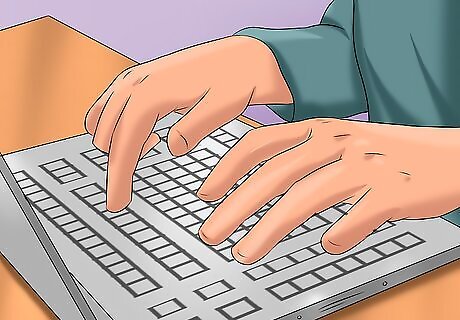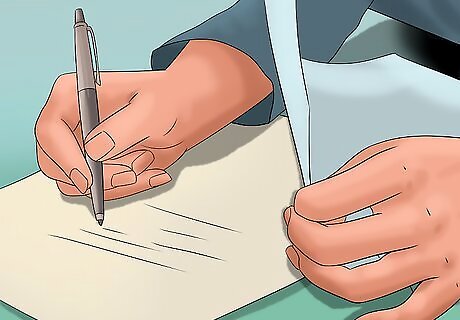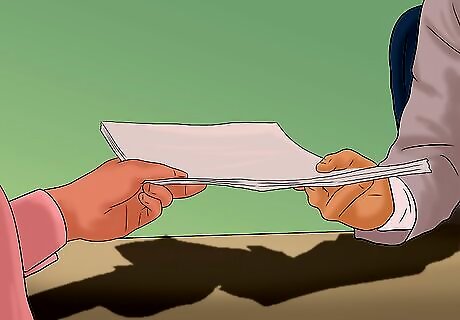
views
X
Research source
Before you write your motion for directed verdict, be sure you analyze the law and any applicable local rules. Once you draft your motion, serve it on the other party and file it with the court in a timely manner. In some circumstances the court may ask you and the other party to argue about the motion in court. If granted, your motion for directed verdict will end the trial, or portions of it, and the judge will rule in your favor.
Contemplating the Motion

Analyze the applicable law. Motions for directed verdict are usually submitted when the other party fails to submit sufficient evidence for a jury to deliberate and decide on a certain issue. In other words, a motion for directed verdict should be used if the other party has not presented enough evidence to meet their burden of proof. The judge will grant your motion for directed verdict if no reasonable juror could honestly reach a different conclusion than the one you are putting forward (i.e., that not enough evidence was submitted to prove the other party's case). The judge will weigh all of the facts in favor of the other party.

Research local court rules. Each court will have different rules regarding the use and submission of motions for directed verdict. These court rules can usually be found online on the courts website. If you cannot find the local rule online, contact the court where your trial is being held and ask for a copy of the local rules. In general, motions for directed verdict must state specific grounds to support your arguments. Be aware that different courts call these motions different things. For example, in criminal court, this motion may be called a motion for directed verdict of acquittal. In a non-jury civil trial, this motion may be called a motion for involuntary dismissal.

Choose when to make your motion. Your motion for directed verdict will be submitted to the court at different times depending on what party you are and what your trial strategy is. Motions for directed verdict can only be filed after your opponent has presented their evidence. If you are in a jury trial, your motion should always be presented outside of the jury's view. If you present your motion while the jury is still present, the court may find your actions prejudicial and your case may be dismissed or delayed. If you are the plaintiff in a civil suit, your motion will usually be submitted after the defendant has presented their case. If you are the defendant in a civil case, you can submit your motion after the plaintiff rests (i.e., right before you present your case). If you are the defendant in a criminal case, you can submit your motion after the prosecution has presented their case. If you are the prosecution in a criminal case, you are not allowed to submit a motion for directed verdict (because defendants have an overriding constitutional right to a jury trial). If you are the defendant and your motion is denied during trial, you can renew your motion after you present your case and rest.

Find available forms. Before you start drafting your motion for directed verdict, look online for valuable forms and templates you can use to help you write. A lot of courts will have blank motion forms available on their websites. Also, a lot of nonprofit legal organizations will offer forms to low income individuals. Conduct online searches for "motion forms" or "directed verdict forms" and see what comes up. If you cannot find forms that match the requirements you need, you may have to create your motion from scratch.
Drafting Your Motion

Draft a notice. A complete motion for directed verdict is a compilation of multiple documents. The first document you will need to create is the notice of motion, which explains to the court that you are asking for a directed verdict. The notice will begin with a caption page, which will need to identify the court, the parties, the case number and the title of your document. Some local rules might require additional information in the caption. In this instance, the title can be something like: "Notice of Motion for Directed Verdict." The body of your notice will state that you are filing a motion for directed verdict based upon the other documents that will be attached to the notice (i.e., the memorandum and declaration). The end of your notice will leave space for you to sign and date.

Create the caption. The second, and most important document you will draft, is the memorandum of points and authorities in support of your motion. This document lays out the law and your legal arguments that support your motion. The memorandum will start with a caption page, which will need to identify the court, the parties, the case number and the title of your document. Some local rules may require additional information (e.g., hearing information or the identity of the presiding judge).

Include a table of authorities. After the caption (or after the table of contents if you created one) you will want to include a table of authorities, which is a list of all the legal authorities you cited to in your memorandum. The list should be separated by court cases, statutes, and other authoritative documents. When you draft your citations, make sure you transcribe them correctly. Next to each citation, include a list of page numbers where the citation can be found in your memorandum. The table of authorities provides the judge with an easily identifiable list of the laws you used to base your motion on. The judge will appreciate having these citations in one place and it will allow him or her an easy way to look up cases and statutes if they have any questions.

Draft an introduction. The introduction to your memorandum will directly follow the table of authorities. The introduction will lay the factual, legal, and procedural foundation of your motion for directed verdict. You should explain that the facts presented by the other party during trial did not meet the required burden of proof. You should explain that, under the law, you are able to file a motion for directed verdict and that it should be granted in this scenario. Make sure to include all of the important facts here in the introduction. Do not make your legal arguments in the introduction. Leave the legal standards and the legal citations for the body of your memorandum.

List your arguments. This is the most important part of your entire memorandum (and motion). When you create each argument, identify the appropriate legal authority, the opponent's burden of proof, and an explanation of why the other party did not satisfy that burden. The best way to organize each argument is usually to state your request, articulate the law, summarize the facts, and apply them in your argument. For example, assume you are a civil defendant and you believe a motion for directed verdict should be granted because the plaintiff did not meet his or her burden of proof during a negligence case. Your argument might be an expanded version of the following: "The motion for directed verdict should be granted because plaintiff failed to adequately establish damages by a preponderance of the evidence. During plaintiff's case, he or she failed to introduce any evidence of damages caused as a result of any alleged breached duty. In a case for negligence, if no cognizable damages were sustained by plaintiff, no case can move forward."

Create a signature block. The end of your memorandum needs to include a space for signatures and dates. Make sure you leave space for the signatures of everyone who helped you write the motion (e.g., attorneys). Every person who is eligible to appear in court and argue must sign the memorandum if they helped you create it.

Include a declaration in support of your motion. In addition to your notice and memorandum, you also need to draft a declaration, which is a sworn statement to the court promising that the facts you include in the declaration are true and accurate. The declaration will begin with a caption page that includes all of the required information. The title might be: "Declaration in Support of Motion for Directed Verdict." The body of the declaration needs to provide your name and a declaration that the facts you are about to provide are true and accurate. The rest of the declaration will list the facts you are relying on in making the motion.

Draft a proposed order. This is an order the judge can sign if he or she decides to grant your motion for directed verdict. You will not sign this document and you only need to leave space for the judge to sign. The proposed order will begin with another caption page. The title can be: "Proposed Order Granting Motion for Directed Verdict." The remainder of the proposed order can state something similar to the following: "Having considered [plaintiff's/defendant's] motion and finding good cause therefore, it is hereby ordered that [plaintiff's/defendant's] motion for directed verdict is granted."

Create a proof of service sheet. The final document in your motion will be a proof of service sheet that requires your server to swear that service was completed in accordance with the law. It will contain a caption page with an appropriate title (i.e., "Proof of Service"). The body of the proof of service sheet will simply state that your server served the documents in the manner provided for by law. You will leave a space for your server to sign and date.
Filing Your Motion

Sign the documents. Once all of the required documents that make up your motion have been drafted, you will need to collect the appropriate signatures in the appropriate spots. The proper signatures will be required before the motion is considered complete. The notice will need to be signed by you and/or your attorney. The memorandum will need to be signed by you and anyone that helped you create the memorandum. The declaration will need to be signed by you. The proposed order will not be signed. The proof of service sheet will be signed by your server as soon as he or she completes service.

Serve the other party. Every document you file with the court will usually need to be served on the other party to your lawsuit. Before you file your motion for directed verdict, copies of the motion need to be served on the other party. At this stage of the litigation, it is usually sufficient to have someone over the age of 18 who is unrelated to the case mail a copy of the motion to the other party or his or her attorney. Remember, once the server mails copies of the motion to the opposing party, make sure he or she signs the proof of service sheet and returns it to you.

File your motion with the court. Once service is complete, you need to take the original motion and file it with the court where your trial is taking place. Be sure you look at the local rules to determine if the court requires you to file copies in addition to the original. For example, in the Central District of California, you are required to file the original plus two copies.

Set a hearing date. At the time of filing you will also set a hearing date so the judge can hear arguments on your motion. The hearing date will also be used to set deadlines for the other party's response. The hearing date cannot be scheduled within a certain window of when you filed your motion. For example, in the Central District of California, the hearing date must be at least 31 days after the date you file your motion and serve the other party. Some courts will allow you to schedule your hearing online while others may require you to call in or schedule in person.

Await a response. The other party will have an opportunity to respond to your motion by filing a memorandum in opposition. The other party's memorandum will look similar to yours but will contain counter-arguments to the arguments you provided in your motion. Read the response carefully as it will give you insight into how the other party is combating your motion. Before you argue your positions in court, make sure you understand exactly why the other party thinks the motion should be denied. Take some time to create counter-arguments that you can use during oral arguments.
Arguing in Court

Show up for your hearing. The hearing you set may or may not be rescheduled or cancelled depending on your judge's schedule and opinion on the motion. Sometimes a judge will simply cancel the oral arguments and decide the motion on the written documents you and the other party provide. However, if the hearing is still on, make sure you arrive early so you have time to park and get through security. Once you get through security you will have to find the correct courtroom and wait for your case to get called. Make sure you come prepared and bring copies of all documents relating to the motion.

Talk with the judge about your motion. When the judge calls your case, walk to the front of the courtroom and prepare to argue your motion. The judge will likely ask questions about your motion and the other party's response. Speak clearly and be polite to the judge and the other party. Answer every questions completely and concisely. Be prepared to expand upon your arguments and make counter-arguments. Do not become flustered if the judge tries to poke holes in your arguments.

Listen to the other party's arguments. The judge will also want the other party's perspective on your motion for directed verdict. When the judge asks the other party questions, listen carefully to the other party's answers and be prepared to counter them. However, never interrupt the other party while they are speaking. Wait until they are done and then ask the judge if you can respond.

Await the judge's decision. When the judge is finished hearing arguments, he or she will make a decision about your motion. Sometimes the judge will make a decision immediately while you and the other party are still in court. In other circumstances, the judge may want to take some time to deliberate. When the judge does make a decision, you will hear about it in court, through the mail, or by visiting the courthouse. If your motion for directed verdict is granted, the trial, or a portion of it, will end and judgment will be entered in your favor. If you lose, the trial will continue and the jury will have an opportunity to decide your case.



















Comments
0 comment